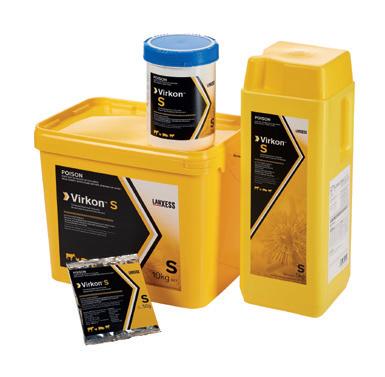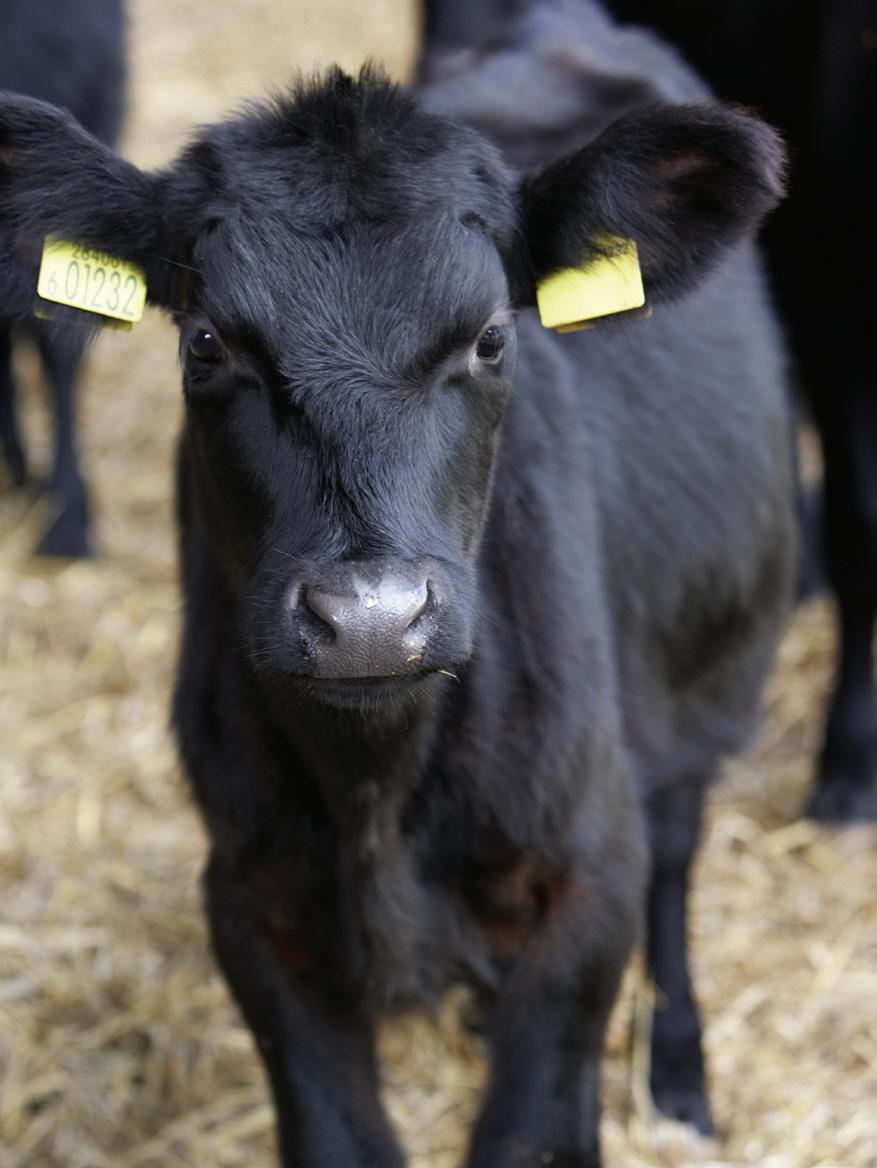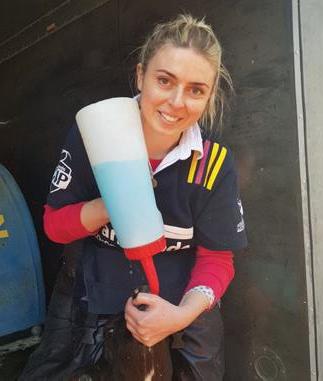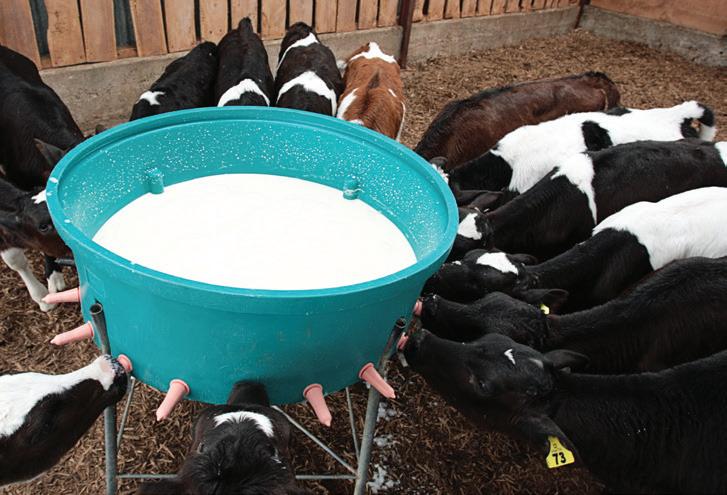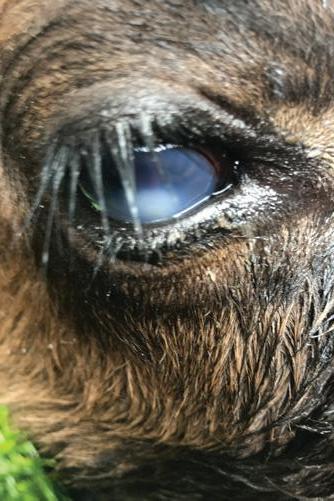
14 minute read
Disease management
The young calf has a very delicate balance between health and disease as their immune system is underdeveloped, relying on passive immunity from colostrum in the first few months.
Disease can come at huge cost and burden to the calf rearer in terms of loss of growth or animal deaths, loss of future production and also in terms of treatment and prevention measures. Attention to detail and monitoring calf health and housing management are the essential tools when trying to prevent disease.
Prevention is better than the cure in terms of both economics and staff morale.
Top tips for preventing disease
• Ensure that people who are picking up fresh calves from the paddocks are as clean as possible. • Ensure calves have adequate colostrum intake in the first few hours of life (see colostrum section). • Feeding a cow pre-calving can have an impact on her calf while in the womb.
A cow that is well fed pre-calving is more likely to have a trouble-free birth and produce a calf that is healthier, more lively and set up to do well. • Ensure calves are fed high quality, clean milk or milk replacer. • Ensure calves always have access to clean water. • Ensure calves have all necessary vaccinations. • Ensure calves have access to a high quality, palatable hard feed, with a coccidiostat included (to prevent coccidiosis). • Decrease stress inducing factors such as transportation, sudden feed changes, poor ventilation, crowding, temperature fluctuations and draughts. These factors can impact disease resistance. • Have a hygienic facility that will minimise exposure to bacteria and viruses.
Use a Broad-Spectrum disinfectant such as Virkon™S. A regular routine to clean and disinfect the shed, water troughs, feeders and surfaces. • Have limited people through the calf shed. Try to keep the same person feeding the calves each day at the same regular time. Have footbaths and a sprayer with Virkon™S available to spray clothing and equipment before and after contact with calves. • Always wash hands with soap and warm water before and after handling calves, feed and feeding equipment. • Keep sick calves in a separate pen away from others. Keep hygiene foremost when handling sick calves including dedicated equipment. • Situate the calf barn away from cows and dairy effluents. Cows can be carriers of disease. • Keep bedding topped up to prevent odours and dampness that builds up.
Put together a management plan and keep careful watch on all calves, intervening early if calves are not doing well or showing signs of illness. Early observation of disease reduces the impact it will have on the animal and will reduce the change of spread to other calves. Twice daily observations by the same person (for consistency) is the gold standard.
Signs that could indicate a sick calf
• Droopy ears • Refusing to drink the milk feed/coming on and off the teat/slow feeding • Calves that are cold to the touch • Standing apart from the group • Abnormal rectal temperature (normal range is 38-39.5oC) • Grunting, whistling or coughing • Abnormal dung (see scours section) • Lethargy/weakness • Sunken eyes/hydration skin test (skin slow to flatten when pinched) • Reluctance to stand • Dull coat • Poor growth • Nasal discharge • A run to the eye • Teeth grinding/salivation • Kicking tummy/unsettled and getting up and down a lot • Swelling of the navel and/ or walking with a stiff gait
Eye irritations leading to pinkeye.
Disease management
Scours
Scouring (diarrhoea) is the most common health issue seen in calves. There are two types of scours seen in calves — nutritional and infectious.
Nutritional scours
Nutritional scours most commonly occur due to dietary changes that are made too rapidly, environmental stressors and/or feeding set-up issues, for example worn teats or feeding height. Nutritional scours are not contagious, but can lead on to more significant health issues as immune function can be compromised during the scour period. However if a nutritional scour is caught early and treated promptly with electrolytes, calves should ‘pop back up’ quickly with no issues.
Prevention:
Calves should not be overfed, diet changes should be made slowly and good quality milk or milk replacers should be used. Make sure milk powder is mixed to specifications and that warm water used isn’t too hot. (Drinking temp should be 38-40°C) Calves should be fed at the same time each day, by the same person if possible. Calves should be fed using teats that induce natural suckling behaviour to stimulate closure of the oesophageal groove and direct milk into the right stomach compartment. Use new teats each season – worn teats can be cause feeding issues.
Infectious scours
Can be caused by bacteria (E.coli and salmonella), protozoa (coccidia and cryptosporidium) and viruses (coronavirus and rotavirus). Infectious scours are contagious, with transmission from calf to calf via faeces, urine, saliva and secretions from the eye, mouth and nose. It’s best to consult your veterinarian when confronted with infectious scouring to ensure targeted effective treatment.
Prevention:
Ensure good colostrum management so calves have good immunity. Maintain strict hygiene procedures — cleaning equipment and pens regularly with an effective disinfectant. Keep calves warm and in a draught-free environment. Run a hygienic facility with good processes in place/ refresh bedding regularly Put new calves into their own pen and don’t mix them with older groups if possible.
Look out for:
Loose, watery, bright yellow or green dung with a strong odour. Can be mucousy (however, don’t rely on dung appearance alone to identify what the issue may be – take faeces samples if worried.) Blood in the dung (indicative of coccidiosis but could also be linked to respiratory infection).
Is it a nutritional or infectious scour?
Take the rectal temperature of the animal. If they have a high temperature (>39.5°C) it is likely to be an infectious scour. Keep monitoring temperatures, compare the temperature of another pen mate that is not showing any signs of sickness. Treatment: Initial treatment for both types of scours is similar. Calves should be fed a good quality electrolyte, which will provide them with energy and water and replace body salts that have been lost through scouring. Electrolytes alone may not provide scouring calves with adequate energy, so it is recommended that milk is still fed as well as electrolytes where possible. In a severe scour situation milk should still not be withheld for more than a 24 hour period. Contact your veterinarian if chronic scouring persists. Separate dosage of electrolyte solution from milk feeds by 30 minutes before, or 4 hours after, a milk feed otherwise it could affect the milk curd in the stomach. Do not add electrolyte to milk or milk replacer, as diluted milk may not curd properly increasing the risk of scours. Calves die from dehydration and a lack of energy when faced with scours – not the scours themselves. A calf can lose 5-10% of their body water from 1 day of scouring. Look out for signs of dehydration by viewing the calf’s eyes, gums and skin.
Calf symptoms dehydration
Diarrhoea 5%
Eyes slightly sunken, skin losing elasticity, calf staggers but still sucking Eyes sunken, skin slow to flatten if pinched, gums sticky, calf depressed Eyes very sunken, skin won’t flatten out if pinched, calf cannot stand 7%
9%
12%
At a water loss of more than 14%, a calf will die.
Suggested electrolyte therapy regime
AM NOON PM OVERNIGHT
Moderate scours Milk 1-2L Electrolytes 2L Milk 1-2L Electrolytes Ad-lib 2-4L Total 6-8L Severe Scours Electrolytes 2L Milk 1-2L Electrolytes 2L Electrolytes Ad-lib 4-6L Total 8-10L
Disease management
Coccidiosis
Coccidiosis is caused by protozoa that destroy the finger-like villi in the small intestine that absorb nutrients. The worst cases of coccidiosis will have bloody scours but most calves won’t have any visible signs and will just have lower growth rates. Ensure calf feeds contain a coccidiostat to aid in the prevention of coccidiosis. In high-risk situations it is a good idea to include a liquid form of coccidiostat in the milk, to aid in the prevention of coccidiosis until calves start consuming enough hard calf feed. All NRM and Reliance calf feeds (except Power Whey) contain the coccidiostat Bovatec1 .
Note: Some coccidiostats can be very harmful to horses, dogs and camelids (llama and alpaca) so make sure they cannot get access to medicated milk/meal. Bobby calves should not be fed a coccidiostat.
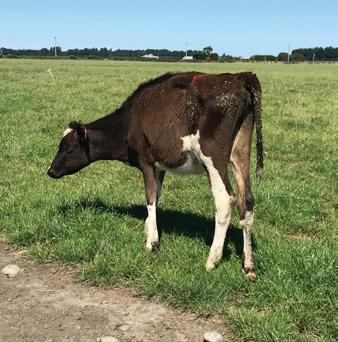
The effects of Coccidiosis after weaning.
Worms and parasites
Calves are most vulnerable to worm burdens in the first 12-18 months of life and it can have a substantial effect on growth and wellbeing. Signs of gut worms: loss of appetite, watery scours, rapid weight loss, poor growth rate, emaciation or death. Similar signs seen in areas of NZ where liver fluke is a problem. Calves with lungworm may cough, have a runny nose, difficulty breathing, and death The use of a combination drench is important to deal with worms that burrow into the gut lining. Prevention: Calves should be on fresh, leafy pasture ahead of the herd and shifted frequently to minimise worms. Drenching for worms should commence around the 8 weeks of age mark, or when calves are routinely out on pasture. Do not add drench to the milk as this can cause toxicity. Continue drenching monthly. Faecal egg counts are a tool to help diagnose worm burdens. This requires taking dung samples to the vet for testing. For more detailed drenching programs its best to talk to your local Farmlands store or vet.
Navel infections
Infections of the navel cord can occur within the first 24 hours of birth. Infection spreads from the navel cord to the liver and the joints. Symptoms can include a hot swollen navel with discharge progressing to painful joints that make it difficult for the calf to walk.
Bovatec® 20CC is registered pursuant to the ACVM Act, 1997. ACVM Registration Number A9679. See www.foodsafety.govt.nz for registration conditions.
Treatment: Take a temperature for signs of an infection. Seek veterinary advice for treatment.
Prevention: Navel infections can be prevented by handling calves with care, avoiding trauma and bruising to the navel. Avoid over- crowding and provide soft/clean bedding during transport. Avoid calves lying in wet/muddy conditions. Spray the navel cord with iodine before picked up from the paddock and again in the shed.
Calf pneumonia
Environmental factors such as low temperatures and high humidity, direct draughts, poor ventilation and a build-up of ammonia gas (poor housing), all can cause pneumonia. A pneumonia infection can be acute (sudden onset), or chronic (long term). Signs include a dull calf, with a dropped head, a rapid respiratory rate, fever, nasal discharge and/or a cough. Treatment: Take a rectal temperature and if elevated, it could mean the calf has an infection and needs an antibiotic treatment - seek veterinary advice without delay. A calf that is coughing and has a nasal discharge with no temperature can be a sign of poor ventilation and stale air and won’t necessarily need antibiotic help. Prevention: Ensure your shed has good ventilation. Ammonia smells at calf height will lead to respiratory issues.
Bloat
Abomasal bloat (right side distension):
Symptoms often appear within 1 hour of feeding, with death resulting from heart failure or asphyxiation 6–48 hours later. It is often due to overfeeding or abrupt diet changes, which encourages the growth of clostridia, where gas builds up and is unable to escape. This type of bloat cannot be relieved by stomach tubing to release the gas.
Ruminal bloat (left side distention):
Usually caused by delivery of milk into the rumen due to the oesophageal groove not closing, or overfeeding of milk which can be due to incorrect height of feeders or worn teats. Normal rumen contractions decrease and belching to remove excess gas becomes impossible. This type of bloat can be relieved by releasing trapped gases via a stomach tube.
Vaccinations
Calves need to be vaccinated against a variety of diseases including leptospirosis – diseases depend on your local conditions. Contact your veterinarian for more details on specific vaccinations programs. Vaccination against clostridial diseases is important for calves - 5 in 1 vaccines are available at your local Farmlands store.
Disease management
Troubleshooting for other common problems
This table covers common problems that arise in New Zealand calf sheds.
Animal signs Possible cause
Lame and/or inflamed joints. Navel infection or joint ill.
Coughing or noisy breathing and/or runny eyes.
Shivering/shaking Respiratory infection or pneumonia.
A draughty shed or inadequate shelter from cold and wet conditions. Shaking during/just after a milk feed could indicate that the calf is full.
Sunken eyes, dry gums.
Kicking belly/unsettled. Dehydration.
Abdominal discomfort caused by overfeeding or potentially a variety of gastrointestinal issues such as colic, bloat, ulcers etc.
Excessive bellowing or unsatisfied calves. Under-feeding.
What to do
Seek veterinary advice. Careful handling when transporting and iodine can help to prevent this.
Increase ventilation, look into your shed health. Make sure bedding is dry. Seek veterinary advice for treatment.
Improve the shed facilities. Use calf covers. Ensure you are feeding warm milk and monitor feeding and avoid over feeding by using division feeders if possible for the first 2 weeks.
Ensure all calves have access to clean water. Scours could be the issue causing dehydration — feed electrolytes.
Check you’re not overfeeding the milk feed. If issues continue seek veterinary advice.
Check your feeding rates and mixing rates of calf milk replacer. Check that they haven’t eaten all hard feed available and need a top up. Make sure there is clean water available and if in the paddock can they actually reach the water.
Not eating calf meal.
Slow milk drinking.
Closed eye/runny eyes Stale or vermin/pest contaminated feed. Feeding too much milk or too much hay/ fibrous feeds on offer. Replace feed regularly. Get rid of feed that calves have slobbered over. Reduce amount of milk. Make hay harder for the calves to get at.
Broken teats. Palatability of stored milk/colostrum. Calf may have been born with poor suckle reflex or calf could have an undiagnosed illness causing reduced appetite. Change teats for new ones. Put slow drinkers together where possible. Ensure stored milk is still palatable and not rancid. Monitor calf health by taking a temperature, look inside mouth for ulcers on the gums or tongue. Iodine levels in the cow pre-calving can affect the suck reflex.
Bruised from being bumped in transport. Environment with dust or pollens. Pinkeye infection. Bumps can occur easily during travel, yarding and feeding. A bruised eye can develop into pinkeye (blue looking ulcers to the eyeball) so watch the calf for eye changes. Anything that effects the eye around dust and pollen can lead onto more sinister issues. Monitor the calves daily and seek veterinary advice.
Disease management
Prior to the arrival of each batch of calves the calf sheds should be throughly cleaned and disinfected with a broad spectrum disinfectant. Pens should be frequently disinfected while in use also to prevent build up of disease organisms.
Virkon™S
Protect calves against disease
Virkon™S is the premium broad spectrum, on-farm, biosecurity solution. A highly convenient, fast-acting, onestop disinfection package for surfaces, equipment, vehicles, aerial disinfection and water delivery systems. Virkon™S is proven to kill disease agents on-farm, even hardy
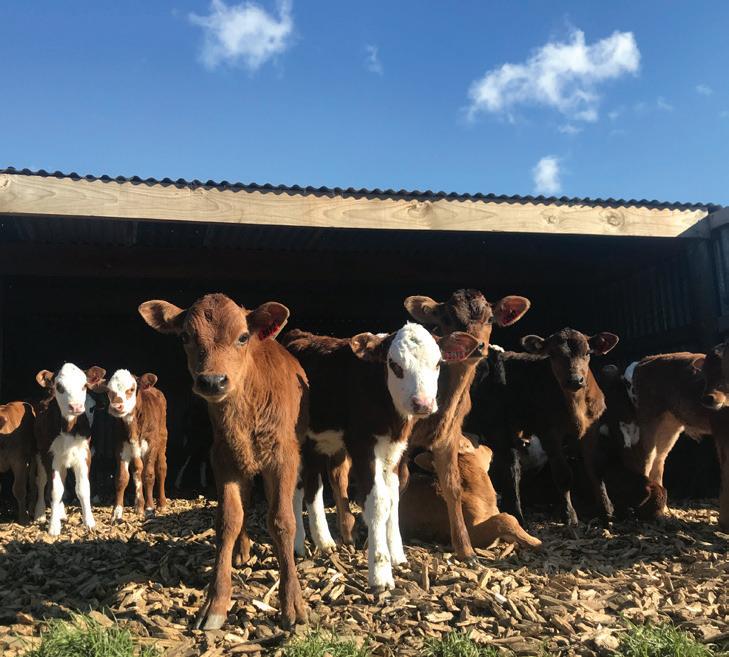
pathogens such as rotovirus and salmonella in calf shed environments and is fully effective against all 18 families of viruses known to man – in addition to bacteria and fungi. Virkon™S is also proven to kill M.bovis and is recommended by MPI.
Calf disease Disease Type Virkon™S effective
Rotovirus virus
Coronavirus virus
Salmonella bacteria
E.coli B bacteria
Campylobacter bacteria
Mycoplasma bovis bacteria
Virkon™S is so effective and rapid acting (30 second - 2 minute kill time) that it is the disinfectant of choice for controlling exotic disease outbreaks internationally. Unlike most disinfectants, Virkon™S does not use glutaraldehyde, which is chemically related to formaldehyde and shares the same dangers. Virkon™S can be misted in the presence of animals. Virkon™S is formulated to degrade naturally within the environment.
Usage information
Treat calf pens and equipment with Virkon™S at the beginning of the season before the calves arrive and continue treating calf pens and equipment regularly throughout the calf rearing season. Treat pens weekly/bi-weekly (depending on disease challenges). There is no need to rotate with other disinfectants and it works in a range of temperatures and in hard water.
Calf sheds and pens
Dilution rate 1:100. Remove all moveable equipment and organic matter (mud, refuse etc.) and using either a pressure washer, knapsack sprayer or watering can, disinfect all surfaces (including in the rafters of sheds) with Virkon™S solution. Allow surfaces to dry before replenishing bedding and replacing equipment. Use the same dilution across all temperature ranges for airborne and surface contamination. Effective in cold temperature and through organic challenge.
Fogging/Misting
Dilution rate 1:200. Spray upwards with a fine nozzle and low pressure in the pens whilst calves are present to help reduce airborne pathogens. Safe to use in the presence of livestock.
